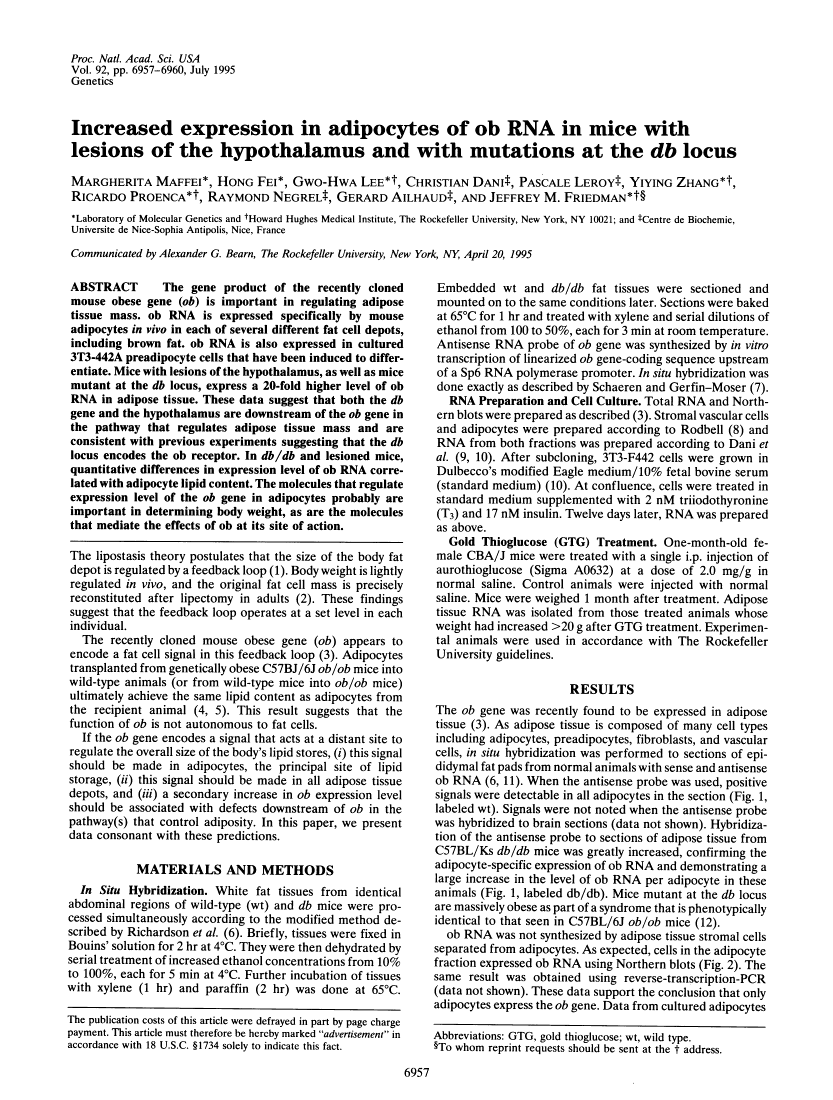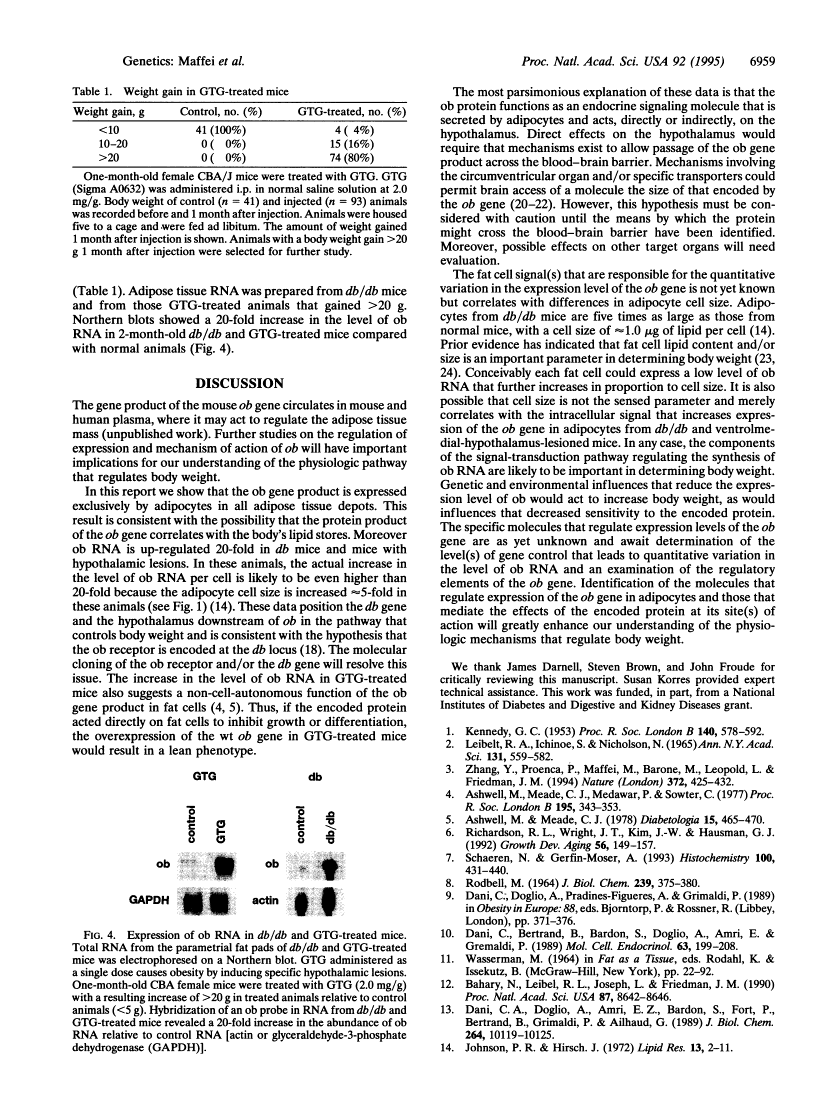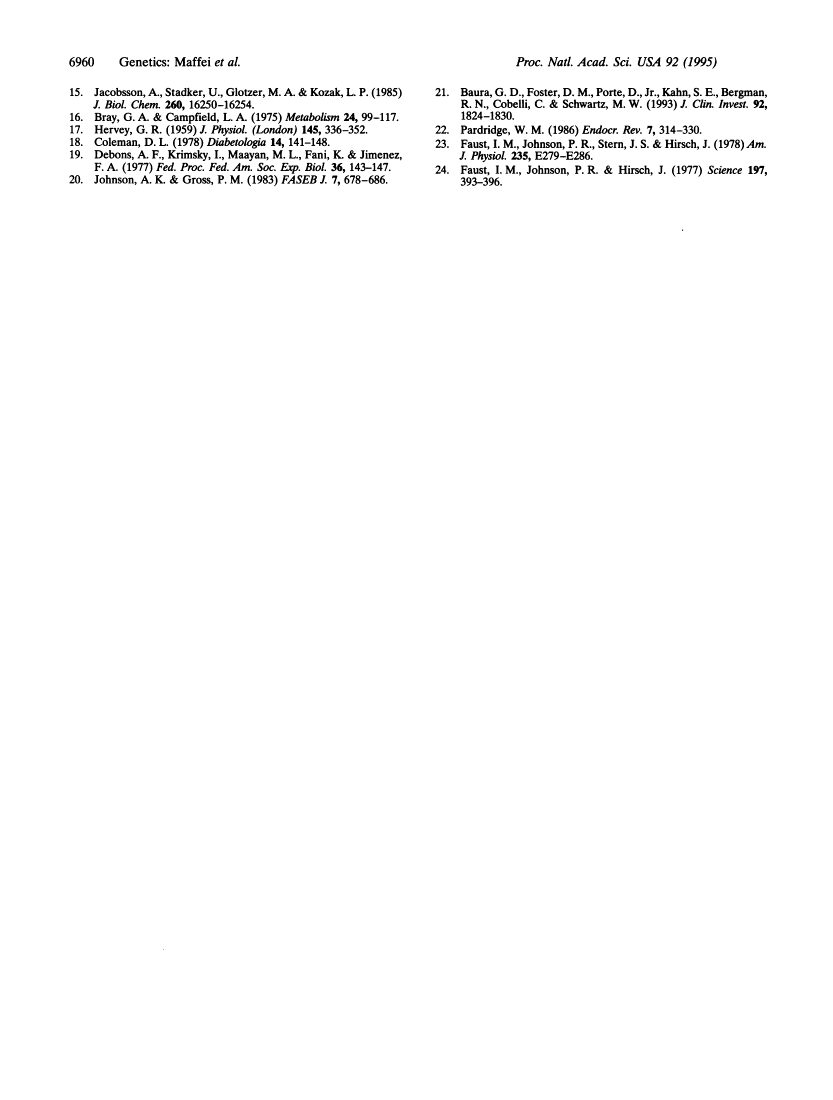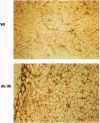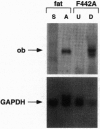Abstract
Free full text

Increased expression in adipocytes of ob RNA in mice with lesions of the hypothalamus and with mutations at the db locus.
Abstract
The gene product of the recently cloned mouse obese gene (ob) is important in regulating adipose tissue mass. ob RNA is expressed specifically by mouse adipocytes in vivo in each of several different fat cell depots, including brown fat. ob RNA is also expressed in cultured 3T3-442A preadipocyte cells that have been induced to differentiate. Mice with lesions of the hypothalamus, as well as mice mutant at the db locus, express a 20-fold higher level of ob RNA in adipose tissue. These data suggest that both the db gene and the hypothalamus are downstream of the ob gene in the pathway that regulates adipose tissue mass and are consistent with previous experiments suggesting that the db locus encodes the ob receptor. In db/db and lesioned mice, quantitative differences in expression level of ob RNA correlated with adipocyte lipid content. The molecules that regulate expression level of the ob gene in adipocytes probably are important in determining body weight, as are the molecules that mediate the effects of ob at its site of action.
Full text
Full text is available as a scanned copy of the original print version. Get a printable copy (PDF file) of the complete article (1014K), or click on a page image below to browse page by page. Links to PubMed are also available for Selected References.
Images in this article
Click on the image to see a larger version.
Selected References
These references are in PubMed. This may not be the complete list of references from this article.
- Liebelt RA, Nicholson N, Ichinoe S. Regulatory influences of adipose tissue on food intake and body weight. Ann N Y Acad Sci. 1965 Oct 8;131(1):559–582. [Abstract] [Google Scholar]
- Zhang Y, Proenca R, Maffei M, Barone M, Leopold L, Friedman JM. Positional cloning of the mouse obese gene and its human homologue. Nature. 1994 Dec 1;372(6505):425–432. [Abstract] [Google Scholar]
- Ashwell M, Meade CJ, Medawar P, Sowter C. Adipose tissue: contributions of nature and nurture to the obesity of an obese mutant mouse (ob/ob). Proc R Soc Lond B Biol Sci. 1977 Jan 14;195(1120):343–353. [Abstract] [Google Scholar]
- Ashwell M, Meade CJ. Obesity: do fat cells from genetically obese mice (C57BL/6J ob/ob) have an innate capacity for increased fat storage? Diabetologia. 1978 Dec;15(6):465–470. [Abstract] [Google Scholar]
- Richardson RL, Wright JT, Kim JW, Hausman GJ. Expression of transforming growth factor-beta (TGF-beta 1) and insulin-like growth factor II (IGF-II) messenger RNA in the developing subcutaneous tissue (SQ) of the fetal pig. Growth Dev Aging. 1992 Fall;56(3):149–157. [Abstract] [Google Scholar]
- Schaeren-Wiemers N, Gerfin-Moser A. A single protocol to detect transcripts of various types and expression levels in neural tissue and cultured cells: in situ hybridization using digoxigenin-labelled cRNA probes. Histochemistry. 1993 Dec;100(6):431–440. [Abstract] [Google Scholar]
- RODBELL M. METABOLISM OF ISOLATED FAT CELLS. I. EFFECTS OF HORMONES ON GLUCOSE METABOLISM AND LIPOLYSIS. J Biol Chem. 1964 Feb;239:375–380. [Abstract] [Google Scholar]
- Dani C, Bertrand B, Bardon S, Doglio A, Amri E, Grimaldi P. Regulation of gene expression by insulin in adipose cells: opposite effects on adipsin and glycerophosphate dehydrogenase genes. Mol Cell Endocrinol. 1989 May;63(1-2):199–208. [Abstract] [Google Scholar]
- Bahary N, Leibel RL, Joseph L, Friedman JM. Molecular mapping of the mouse db mutation. Proc Natl Acad Sci U S A. 1990 Nov;87(21):8642–8646. [Europe PMC free article] [Abstract] [Google Scholar]
- Dani C, Doglio A, Amri EZ, Bardon S, Fort P, Bertrand B, Grimaldi P, Ailhaud G. Cloning and regulation of a mRNA specifically expressed in the preadipose state. J Biol Chem. 1989 Jun 15;264(17):10119–10125. [Abstract] [Google Scholar]
- Johnson PR, Hirsch J. Cellularity of adipose depots in six strains of genetically obese mice. J Lipid Res. 1972 Jan;13(1):2–11. [Abstract] [Google Scholar]
- Baura GD, Foster DM, Porte D, Jr, Kahn SE, Bergman RN, Cobelli C, Schwartz MW. Saturable transport of insulin from plasma into the central nervous system of dogs in vivo. A mechanism for regulated insulin delivery to the brain. J Clin Invest. 1993 Oct;92(4):1824–1830. [Europe PMC free article] [Abstract] [Google Scholar]
- Pardridge WM. Receptor-mediated peptide transport through the blood-brain barrier. Endocr Rev. 1986 Aug;7(3):314–330. [Abstract] [Google Scholar]
- Faust IM, Johnson PR, Stern JS, Hirsch J. Diet-induced adipocyte number increase in adult rats: a new model of obesity. Am J Physiol. 1978 Sep;235(3):E279–E286. [Abstract] [Google Scholar]
- Faust IM, Johnson PR, Hirsch J. Surgical removal of adipose tissue alters feeding behavior and the development of obesity in rats. Science. 1977 Jul 22;197(4301):393–396. [Abstract] [Google Scholar]
- Jacobsson A, Stadler U, Glotzer MA, Kozak LP. Mitochondrial uncoupling protein from mouse brown fat. Molecular cloning, genetic mapping, and mRNA expression. J Biol Chem. 1985 Dec 25;260(30):16250–16254. [Abstract] [Google Scholar]
- Bray GA, Campfield LA. Metabolic factors in the control of energy stores. Metabolism. 1975 Jan;24(1):99–117. [Abstract] [Google Scholar]
- HERVEY GR. The effects of lesions in the hypothalamus in parabiotic rats. J Physiol. 1959 Mar 3;145(2):336–352. [Abstract] [Google Scholar]
- Coleman DL. Obese and diabetes: two mutant genes causing diabetes-obesity syndromes in mice. Diabetologia. 1978 Mar;14(3):141–148. [Abstract] [Google Scholar]
- Debons AF, Krimsky I, Maayan ML, Fani K, Jemenez FA. Gold thioglucose obesity syndrome. Fed Proc. 1977 Feb;36(2):143–147. [Abstract] [Google Scholar]
- Johnson AK, Gross PM. Sensory circumventricular organs and brain homeostatic pathways. FASEB J. 1993 May;7(8):678–686. [Abstract] [Google Scholar]
Associated Data
Articles from Proceedings of the National Academy of Sciences of the United States of America are provided here courtesy of National Academy of Sciences
Full text links
Read article at publisher's site: https://doi.org/10.1073/pnas.92.15.6957
Read article for free, from open access legal sources, via Unpaywall:
https://www.pnas.org/content/pnas/92/15/6957.full.pdf
Citations & impact
Impact metrics
Citations of article over time
Alternative metrics
Article citations
Fiery Connections: Macrophage-Mediated Inflammation, the Journey from Obesity to Type 2 Diabetes Mellitus and Diabetic Kidney Disease.
Biomedicines, 12(10):2209, 27 Sep 2024
Cited by: 0 articles | PMID: 39457523 | PMCID: PMC11503991
Review Free full text in Europe PMC
Adipokines in the Crosstalk between Adipose Tissues and Other Organs: Implications in Cardiometabolic Diseases.
Biomedicines, 12(9):2129, 19 Sep 2024
Cited by: 0 articles | PMID: 39335642 | PMCID: PMC11428859
Review Free full text in Europe PMC
Key Considerations for Studying the Effects of High-Fat Diet on the Nulligravid Mouse Endometrium.
J Endocr Soc, 8(7):bvae104, 25 May 2024
Cited by: 0 articles | PMID: 38854907
Dysfunction of the Brown Adipose Organ in HFD-Obese Rats and Effect of Tart Cherry Supplementation.
Antioxidants (Basel), 13(4):388, 23 Mar 2024
Cited by: 0 articles | PMID: 38671836 | PMCID: PMC11047636
Molecular and Cellular Mechanisms Underlying the Cardiac Hypertrophic and Pro-Remodelling Effects of Leptin.
Int J Mol Sci, 25(2):1137, 17 Jan 2024
Cited by: 0 articles | PMID: 38256208 | PMCID: PMC10816997
Review Free full text in Europe PMC
Go to all (253) article citations
Data
Similar Articles
To arrive at the top five similar articles we use a word-weighted algorithm to compare words from the Title and Abstract of each citation.
Regulated expression of the obese gene product (leptin) in white adipose tissue and 3T3-L1 adipocytes.
Proc Natl Acad Sci U S A, 92(20):9034-9037, 01 Sep 1995
Cited by: 295 articles | PMID: 7568067 | PMCID: PMC40918
Regulation of expression of ob mRNA and protein by glucocorticoids and cAMP.
J Biol Chem, 271(10):5301-5304, 01 Mar 1996
Cited by: 253 articles | PMID: 8621378
Regulation of PPAR gamma gene expression by nutrition and obesity in rodents.
J Clin Invest, 97(11):2553-2561, 01 Jun 1996
Cited by: 428 articles | PMID: 8647948 | PMCID: PMC507341
Regulation of energy balance by leptin.
Exp Clin Endocrinol Diabetes, 104(4):293-300, 01 Jan 1996
Cited by: 99 articles | PMID: 8886745
Review
